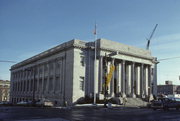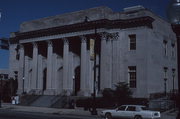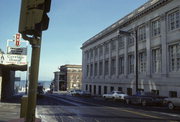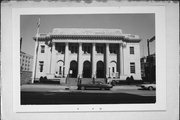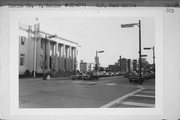| Additional Information: | A 'site file' exists for this property. It contains additional information such as correspondence, newspaper clippings, or historical information. It is a public record and may be viewed in person at the Wisconsin Historical Society, State Historic Preservation Office.
BALUSTRADE ABOVE DENTICULATED CORNICE FLUTED CORINTHIAN COLUMNS ACROSS FRONT ENGAGED CORINTHIAN COLUMNS ON SIDES. ORIGINALLY OCCUPIED 6/1931. Builder was Mads Madsen Co. Wetmore was the supervising architect of the U.S. Treasury Department for over 45 years.
DESIGNED BY JAMES A. WESTMORE. IT IS CHARACTERISTIC OF THE MONUMENTAL AND CLASSICAL STYLE WHICH BECAME THE RULE FOR FEDERAL BUILDINGS FROM THE 1890s TO 1930s.
The first post office in Racine Township, Milwaukee County, was established February 25,
1836, with A. B. Saxton as postmaster. It was called Root River, Michigan territory. Saxton was
succeeded on April 12, 1836, by Bushnell B. Cary, and the office was transferred to Racine, then
a frontier village. On July 3, a bill creating the territory of Wisconsin was approved by President
Andrew Jackson, and the office was thereafter referred to Racine, Wisconsin territory. At the
time, mail was transferred by horseback from Chicago to Green Bay once a week. It was
reported in the Racine Argus in 1838 that “the post office receipts for the first year in Racine
were for over $600; such an instance was unheard of, even among the most enterprising villages
of the west.” Ten years later, the postmaster reported that almost 2,000 letters were sent from this
post office every month.1
The site of the post office has since changed numerous times, including:
• 1838 – east side of Main Street between Second and Third Streets;
• 1843 – west side of Main Street just north of Third Street;
• 1845 – west side of Wisconsin Street, midway between Fourth and Fifth Streets;
• 1850 – west side of Main Street, second door south of Third Street;
• 1859 – Third Street near Chatham Street;
• 1862 – east side of Main Street; and
• 1874 – northeast corner of Main and Fifth Streets.
During its early history, the staff of the Racine Post Office principally consisted of the
postmaster. The facility was appointed its first mail carriers in 1883, five in total. Finally, in
1897, the Post Office Department purchased property at the southeast corner of Main and Sixth
Streets for $30,000. Prior to the Post Office Department’s purchase, the home of Robert H.
Baker, an executive of J.I. Case Company, was located on this site. A large castle-like building
with large towers and turrets was built for $70,000 to serve as Racine’s first permanent post
office.
By 1924, the post office had 103 workers consisting of a postmaster, six supervisors, 39 carriers,
42 clerks, 4 rural carriers, plus extras. Its postal receipts amounted to nearly a half million
dollars. Receipts continued to rise and reached $634,000 in 1929. Because of an increase in local
business activity, a more modern post office was needed. Consequently, postal operations were
transferred into the old Shoop Building on East State Street while the old post office was
demolished to make room for the present post office.
Congress appropriated funds for the new post office on October 18, 1928. Congressman Henry
Allen Cooper was the driving force behind securing the appropriations for the new facility. He
was a First District Representative elected to nineteen terms. He died on March 1, 1931 shortly
before the completion of the post office.
James Alfonso Wetmore (1863-1940), Acting Supervising Architect for the U.S. Treasury, had
charge of the designing Racine’s Post Office. He had entered the department as a stenographer,
but had learned architecture after being assigned to this office. As supervising architect, he had
overall responsibility for the design of at least 2,000 Federal buildings.
Wetmore used the popular and conservative Neo-Classical style, which displayed fluted
Corinthian columns and pilasters, to give Racine’s new post office a sense of imposing dignity
(Figures 10 and 11). As originally laid out, the post office featured two lobbies, one extending
the larger part of the front portion of the structure and the other being located on the south side.
The facility was opened and which hundreds of residents of Racine toured before it was opened
on the Monday July 27, 1931. It is interesting to note that at the same time as the U.S. Post
Office was being built, the Racine County Courthouse, designed by Holabird & Root, and the
Racine City Hall, designed by J. Mandor Matson, were also under construction (Figure 12).
Postal receipts soon fell due to the Great Depression to a low of $350,000 in 1933. The post
office was organized into six departments under the direction of Postmaster George A.
Rickeman. At this time, all of the postal routes were foot routes and the mail was delivered twice
a day (three times a day downtown) (Figure 13). Carriers with their pouches full of mail traveled
by streetcars, and later buses, to their routes. Post office trucks would take mail they couldn’t
carry to relay boxes where the carriers would pick up their bundles. First class stamps cost three
cents. Carriers were not allowed to have long hair, beards or mustaches and were subject to
uniform inspections twice a year. |
|---|
| Bibliographic References: | Assessor's records.
Gregory, John G., ed. Southeastern Wisconsin: A History of Old Milwaukee County. Chicago: S.J. Clarke Publishing Co., 1932, Vol. 1, p. 516.
HISTORIC 6TH STREET BUSINESS DISTRICT WALKING TOUR GUIDE, 1990
Renewing Our Roots: A Guide To Racine, Wisconsin, Central City, Southside, Preservation-Racine, 1977. |
|---|

